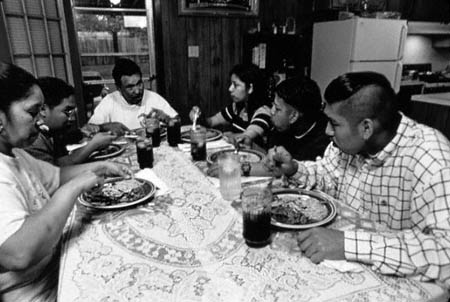Crossing Over: A Mexican Family on the Migrant Trail
Rubén Martínez
Metropolitan Books, $26 (cloth)
Mexico has evolved from a sedentary country to a nomadic one.
—Carlos Monsiváis
Above is an image of Latino life that challenges us as viewers to make sense of it. It comes from the ongoing collaboration between photographer Joseph Rodriguez and journalist-performer Rubén Martínez, and suggests the sorts of quiet, elusive dramas that mark the migrant experience—in this case, the experience of the Tapia family, whom Martínez follows in Crossing Over from the Mexican city of Cherán to Warren, Arkansas.Raúl Tapia sits at the head of the dinner table, flanked by his wife Yolanda and their children. His index finger is hovering in mid-air and the children to his left seem to be weighing some point he has recently made, but his own expression is quizzical and slightly troubled—as if he were held in the same suspense as his children. The photograph’s most magnetic figure, in counterpoint with Raúl, is the son in the far right foreground, who blends deference and defiance. Although he wears a crisp button-down shirt, it is cut in the current baggy urban fashion and his hair has been shaved and styled in a slick hip-hop update of the punk mohawk. His face, turned at an oblique angle from the camera, is unreadable. Surely the photograph illustrates the family’s achievements—there’s a full meal to be eaten, and a full complement of sons and daughters around their parents—but it’s also contrived to make us wonder about the future of this Mexamerican Dream, what will happen after the kids leave smalltown Arkansas and the family table.
Martínez’s reporting helps fill in the details behind the ambivalence in the dining room. Raúl, we learn, first migrated to the United States in 1968, and has secured a middle-class existence for his family (home ownership, the prospect of college educations) largely through hard labor, first as a tomato picker and now as part of a street maintenance crew for the city. Although he is only one generation away from a monolingual Indian life in the highlands of Cherán (speaking Purépecha, not Spanish), he has urged his kids to throw themselves into their American life—and they have. Rudy and Adam, twenty-one and nineteen, are the hip-hop sons of the Tapia family, and they speak an idiom that Martínez later calls “equal parts Ebonics and Arkansas dialect”: “We lived in this housing project once,” says Adam, “and most of my friends were black. That’s who we be associating with more, y’know.” His sister Maribel also mixes it up: although she’s an avid student of Chicano history—with a special interest in César Chávez and Emiliano Zapata, and hopes of publishing a story in the Chicano ‘zine Lowrider—her social world is equal parts white, black, and Mexican. The future of young people like Rudy, Adam, and Maribel is, quite literally, unwritten—a fact registered in the furrowed brow of their father.
These details are all sensitively reported, but what gives them special force in Crossing Over is the book’s angle of vision. In Martínez’s writing, as in the Rodriguez photos that introduce every chapter, intimacy and dislocation stand in taut relation to one other. Here, in the Tapia family photograph, the position of the camera—at the opposite end of the table but elevated and skewed to the left—gives us the sense that we’re in the thick of the action but a little above it too. We might be getting out of our chair, leaning over the table for a better view, or sitting straight up like daughter Maribel, at polite attention. There’s both a sense of open space, with our eyes tracking along the elongated table to its diminutive figurehead, and a faint claustrophobia, the hint of elbows bumping into one another. And lastly, there’s something both inclusive and jarring about how the Tapias themselves relate to the camera. We seem to be sitting unnoticed at the dinner table, but it’s impossible to tell if we’re intimately involved with the Tapia clan or if we’ve just been given permission to spy on them.
It is through such off-balance perspectives that Crossing Over invites us, as viewers and readers, to stand in the travelling shoes of the migrant. The book may be the thickest description yet of what it feels like to be caught always between sitting down and getting up, between making human connections and severing them, in that transnational zone known as la frontera. The term conventionally refers to the 2000-mile-long zone that stretches along the U.S.-Mexico border, a region dominated demographically by explosively growing twin cities such as San Diego-Tijuana (4.3 million residents and 719 maquiladoras) and El Paso-Ciudad Juárez (1.5 million residents and 372 maquiladoras). As Martínez, Mike Davis, and many others have argued, and as the WTO and IMF protests have begun to highlight, this frontera is defined by the attempt to institute, simultaneously, a barricaded political border and a borderless economy.1 While NAFTA has spurred Mexican border states to dole out tax relief to North American and Asian firms, it has not stimulated much investment in the basics of public infrastructure: 40 percent of Tijuana’s residents, for instance, still live without sewer hookups and running water. Nor has the influx of new international business driven up wages: Since 1981, the average maquiladora wage rate has declined by 65 percent. Unsurprisingly, Mexicans continue to be drawn north by the promise of higher wages and a better life for themselves and their families. In this context, the Border Patrol’s much-vaunted 1.5 million arrests per year are better understood as a sign of the intensity of northern migration than as an effective strategy for a border lockdown.
These statistics—demographic, economic, sociological—have a certain bald force, but it is intercessors like Martínez who do the difficult work of translating them back into a human calculus of pain and hope. What kinds of lives has “free trade” produced? Martínez’s counterintuitive but compelling argument is that globalization—with its transnational flows of commodities and human capital—has provoked a resurgent sense of local identity south of the border. In the small inland Mexican city of Cherán, where Martínez spends the first half of his book, migradollars may float the local economy, but migradollars have hardly tamped down the expression of Purépechan indigenismo.
Quite the contrary: Martínez is continually meeting people who appropriate the materials of globalization for local uses. He stumbles upon traditional healers who counsel AIDS awareness, business entrepreneurs who dispense folk remedies on the side, migrant workers who love Michael Jordan because his game mimics the pace of their lives, bullfighters who snort cocaine and wear Ray-Bans with their suit of lights, and disc jockeys who propagandize for rock n’ roll as a source of Purépechan pride. Martínez has little patience for those cosmopolitans who prefer their Indians in a state of folkloric purity, “burning incense in rites to the gods of rain and wind and fire, preserved as in a diroama at the Museo de Antropología e Historia in Mexico City.” For him, the people of Cherán are a set of variations on a very different theme—the reinvention of tradition through the impure materials of the now. In a striking irony, he notes, this newly synthetic migrant culture recalls the very foundation of Cherán’s local Indian identity: the word “Purépecha” means, loosely, “a people who travel.”
Since the mid-1980s, Martínez has been something of a local phenomenon in Los Angeles—the co-host of a public affairs TV show, and a reporter for the LA Weekly whose work (some of it collected in The Other Side: Notes from the New L.A., Mexico City and Beyond) is enlivened by his gift for fast friendship and his patience with ethical complexity. More recently, he developed a performance called Border Ballad, which was driven by the same bricolage aesthetic that he sees taking over Cherán. Accompanied by the seminal East L.A. punk band Los Illegals, Martínez spliced storytelling and song, interpolating tales of the border with versions of Johnny Cash’s “Fulsom Prison Blues” in Spanish, David Bowie’s “Heroes” in bolero-rock style, and Hank Williams’s “I’m So Lonesome I Could Cry” with a Mexican ranchera beat. Border Ballad disclosed Martínez as a performer attuned to sonic mestizaje.
Crossing Over should bring Martínez a wider audience, not least because its portrait of migrant lives is so unmistakably and unpredictably humane. There are few saints in the book, and even fewer villains. (Martínez’s one extended portrait of a Border Patrol officer is remarkably sympathetic, especially given his strong objections to her paramilitary mandate.) Perhaps the most striking undercurrent in the book, though, is its insistence on the creative uses of pain—which is not to say that migrant suffering is particularly ennobling to the sufferer, simply that it calls out to be expressed and often is channeled into stunning social dramas. The book opens with an indelible tableau of Good Friday in Iztapalapa, a district just south of downtown Mexico City. The district is famous for the pageantry of its representación, its collective simulation of the drama of Christ’s crucifixion. An estimated two million people arrive for the pageant when Martínez is in town; he witnesses five thousand young boys and men dressed as Christ—some carrying “the better part of a tree” over their shoulders—dragging their crosses through the barrios and up the hill to their Golgotha.
Martínez notes, as do several contemporary onlookers, that this almost lurid embrace of suffering—the boys feel their feet sizzle on the asphalt; several need to be carted off by the Red Cross—has much to do with the social crisis in Mexico. His narrative raises itself to the pitch of incantation as he watches a specially appointed Christ being hammered to the cross:
In the final moments of the Passion, the gray wind of Iztapalapa rises in great clouds about the massive crowd. It is the gray of the great dust of the city, not just the arid topsoil of the Cerro but particles of ash from the billion cigarettes of the chain-smoking city, refuse from the garbage dumps on every street corner in the barrios, sooty exhaust from the trucks and taxis and the passenger cars of the rich and poor, especially the poor with their jury-rigged eight-cylinder smoking Chevys—the dust of poverty, the dust of corruption, the dust of hell on earth
As we bring handkerchiefs to our faces and rub our eyes, everything that was white turns gray: the robes of the nazarenos, the blocks of ice at the vending stalls, the pages of my notebook. On this Good Friday the holy, fallen country has come to watch itself die.
And live.
It is accomplished.
Martínez’s prose is at once shimmering and gritty—a perfect match for a narrative that may have few actual saints, but has plenty of self-consciously uncertain aspirants to the title.
Some readers, captivated no doubt by this prose style, have started praising Crossing Over as a sort of twenty-first-century sequel to James Agee and Walker Evans’s Let Us Now Praise Famous Men. Agee brought to light the complex difficulties of sharecropper life in an America shattered by the Great Depression, so the thinking goes, and now Martínez has given voice to those migrants who do America’s dirty work—harvesting crops, washing dishes, slaughtering cattle, stitching clothes—while hidden in the underbelly of the New Economy. The comparison may work well as dust-jacket copy—Crossing Over deserves to be taken up by today’s student activists, just as Let Us Now Praise was taken up by students heading down to the Southern delta or into Northern slums in the 1960s—but it also may obscure a fundamental difference between the two. Agee traveled to Alabama on an ostensibly one-month assignment for Fortune magazine, hoping to produce a detailed portrait of tenant families for a mass audience. Five years later, after much dickering with Fortune and an unsympathetic editor at Harper & Brothers, he came up with something far more interesting and far more anguished—an intense, rambling 500-page meditation on the gap between the concerned intellectual and his sharecropping subjects, and on his desire to bridge that gap. The gap itself was taken as a given: Agee’s tenant families were icons of a fading rural past, while the author himself was drawn to Henry Luce’s publishing empire and Hollywood dream factories.
Martínez, by contrast, spent the better part of four years living among Cherán’s migrant families and reporting, intrepidly and sympathetically, from the border-zone. (At one point, he followed a group of paint-inhaling juveniles down into the tunnels they frequent beneath the twin cities of Nogales, and found himself wading through a lake of shit and piss.) The protracted experience seems only to have confirmed Martínez’s hunch that there was a symmetry between his own life, as a reporter-performer in the professional-bohemian mold, and the lives of his subjects, who were always reinventing themselves and their culture in a spirit of cockeyed, needful improvisation. Unlike Agee, then, who was drawn to elegy, Martínez is drawn to prophecy: he sees the provinces as the future, the towns of Cherán and Warren as the shape of things to come.
This is a heady proposition, given that we usually think of large cities—with their greater diversity, fluidity, and scale—as the incubators of our future; the very term ‘provincial’ has come to mean narrow-minded. Could it be the case that the hybrid culture of Cherán, population 30,000, can tell us more about our uncertain future than, say, the D.C. neighborhood of Adams-Morgan or the gated communities of our suburbs? The argument seems especially strange given the patterns of Latino settlement in the United States. As Mike Davis has observed, Latin American immigrants have had their primary impact on the U.S. cities where they’ve congregated, “tropicalizing” the industrially-zoned areas vacated by an older Anglo working-class. Are we to believe that migrant cultures will soon make themselves felt in the great ‘red’ zone carried by George W. Bush?
Perhaps. Martínez’s argument deserves serious consideration, for both demographic and moral reasons. As Harvard sociologist Christopher Jencks points out in a recent New York Review of Books essay, if immigration trends were to persist for the next half-century, the U.S. population would double—to more than 500 million—by the year 2050. At first, Jencks writes, this seemed like fanciful speculation, until he began considering that there are few political constituencies looking to reduce immigration—witness the decision by the AFL-CIO last year to organize immigrants, rather than protest their numbers—and every reason to think that pro-immigration constituencies (e.g., established immigrants who would like to ease the arrival of their relatives) will grow in strength. Mike Davis more conservatively predicts that the U.S. Latino population will swell to a little under 100 million by 2050. If either of these figures are close to correct, then the culture of cities like Cherán may very well become as familiar to twenty-first-century Wisconsinites as the blues culture of the Mississippi Delta became to twentieth-century Chicagoans.
Then there is the moral impetus behind Martínez’s prophecy. At times Crossing Over makes a strong case that the mestizaje of the Cherán migrants—which comes out of their struggle to reclaim their roots while being carried far and wide by the forces of globalization—is aesthetically and ethically more compelling than the self-consciously sophisticated “cosmopolitanism” of urban elites. The book’s ethical center of gravity is elsewhere, though: Martínez is more comfortable listening than on the attack. He tends to make the softer claim that the cultural frontera has its own magnetism—that it pulls people into its circle, just as it appropriates such diverse materials as ESPN and Catholicism for its own uses.
Crossing Over ends, in this spirit, with Martínez himself pulled into an Apostolic church in the Mojave desert. The service is syncretic almost to the point of hallucination. Though the preacher’s sermon carries a definite black Baptist cadence, he switches between Spanish and English effortlessly, speaking Spanish with a slight gringo accent and English with a slight Mexican accent. A group of teenage Chicanas sing a hymn with the flourishes of the gospel tradition, to the ecstatic applause of the congregation. And then one girl starts speaking in tongues, the spirit having “moved her to jump up and down like a fan at a ska concert.” She is utterly possessed, and, though incomprehensible, all the more powerful for it. This is where Crossing Over leaves us—with the twin feelings of inspiration and bewilderment, in a place that sounds, to this reader at least, like the future.








